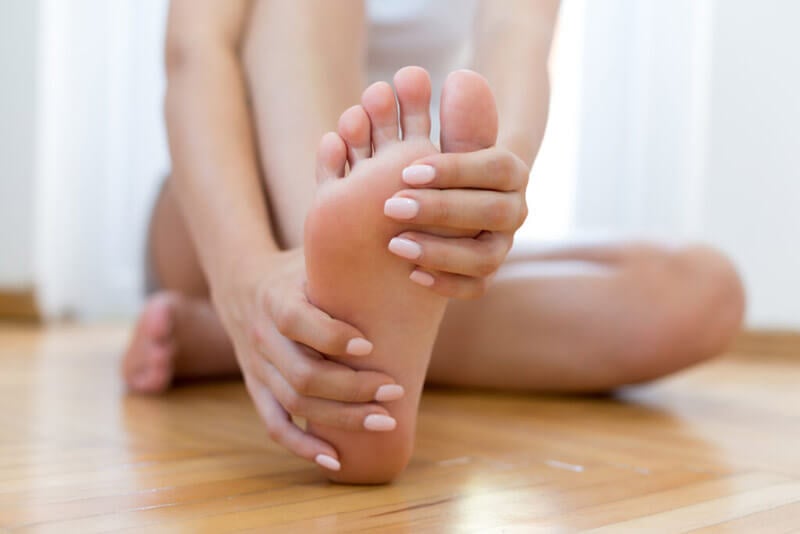Diabetes Feet Problems
Diabetes foot problems are an important concern for anyone who has been diagnosed with the condition to be aware of. As a diabetic, you are at a greater risk of developing health issues in your feet due to nerve damage and poor circulation – some of which can cause severe harm and even result in the need for amputation.
This article goes into more detail about why diabetic foot problems occur, common diabetes feet issues and symptoms to watch out for, as well as possible treatment options. It also discusses diabetic foot care and preventative measures you can use to keep your feet healthy.
We do not recommend to use Footner products for Diabetes patients, we suggest that you consult with your GP before trying new foot care products.
Read on to discover
What happens to your feet when you have diabetes?
Diabetes is a health condition that causes your blood sugar levels to become too high. There are two main types of the disease:
- Type 1 diabetes – a rarer form, in which your immune system attacks and destroys the cells in your body that make insulin (a hormone that controls the amount of sugar in your blood).
- Type 2 diabetes – a more common form, in which your body either doesn’t produce enough insulin or your cells don’t react to it.
So, how does this relate to diabetes foot problems? Whichever type of diabetes you have, it can increase your risk of developing a number of other medical conditions such as heart disease, stroke, vision loss, and kidney problems. In addition, over time, high blood sugar levels can damage your nerves and reduce blood flow – two factors that can have a big impact on the health of your feet.
Having poor circulation means that the blood supply to your feet is reduced, which in turn makes it more difficult for cuts, diabetic sores on feet, and other types of wounds to heal. This is a type of organic peripheral vascular disease and can also be a cause of foot pain with diabetes.
Meanwhile, damage to your nerves can reduce sensation in your feet. This is known as diabetic neuropathy and can result in pain, tingling, and numbness as well as harming your ability to feel heat, cold and pain. In turn, this means you might not realise when you suffer an injury or something is irritating the skin of your feet, which makes it more likely that a diabetic wound will get worse and maybe even become infected. If you don’t spot a diabetes toe infection or similar early on, the resulting damage can be severe.

Symptoms of diabetic feet problems
There are a number of signs of diabetes foot problems that it’s important to watch out for. As a general rule, if you have diabetes, you should check your feet carefully every single day to spot any changes or damage. The sort of symptoms you should keep an eye out for include:
- Cuts, sores, blisters, and other types of wounds
- Corns and calluses
- Dry or cracked skin
- Changes in the colour of the skin
- Changes in skin temperature
- Swelling in the feet, ankles, or legs
- Ingrown toenails
- Thickened and/or yellow toenails
- Odour that won’t go away
- Stains on your socks
- Pain or tingling in the feet or legs
- Numbness or loss of feeling in the toes or feet
- Hair loss on the legs or feet
- Changes in the shape of your feet
When you have diabetes, swollen legs and feet or redness and warmth in the area are not the only signs of infection you should be aware of. Infections can also cause broader symptoms such as nausea, fever, chills, and shaking. If you experience any of the signs and symptoms listed above, seek medical assistance straight away.
What are common diabetes foot problems?
The most common diabetes foot conditions are actually the same sorts of issues that anyone can get with their feet. The main difference is that with diabetic foot problems, there is a greater risk of complications developing and the conditions becoming more serious. This is usually because nerve damage means you don’t notice the problem early on, or poor circulation slows down healing.
Below are some of the main diabetic toe and feet problems you may experience:
- Blisters – small pockets of fluid under the skin
- Calluses – patches of thickened and hardened skin
- Corns – calluses made of dead skin
- Foot ulcers – open sores
- Athlete’s foot and other fungal infections
- Dry skin
- Heel fissures – cracks in the skin of the heels
- Bunions – bony lumps on the side of the foot
- Ingrown toenails – when the toenail curves and grows into the flesh of the toe
- Plantar warts
- Edema – swelling in the feet and ankles
Possible complications of diabetic foot problems
When you have diabetes, spotting and treating foot problems early on is crucial. Even with a seemingly minor issue such as cracked feet, diabetes can slow down healing and prevent you from noticing the damage. Although rare, diabetes feet problems can have severe complications. These might include:
- Infections – even small wounds can lead to infections in the skin or bone
- Wounds that don’t heal
- Deformities – diabetes can weaken foot muscles and result in damage to the structure of the foot
- Abscesses – when an infection worsens and forms a pocket of pus
- Charcot foot – when the shape of your foot changes due to weakened bones, dislocated joints, and other types of damage
- Gangrene – when blood flow to your toes or feet is cut off and causes tissue death
- Amputation – in severe cases of infection, abscesses, or gangrene, amputation may be required
- Death
As such, it’s vital that you see a doctor immediately if you have any diabetes foot issues or concerns about the health of your feet.
Treatment for diabetic foot problems
The method for treating diabetic feet will depend on the specific issue you have and the severity of the condition. Doctors will generally attempt non-surgical treatment first, then consider surgery in more serious cases and those where other methods fail. Possible treatment options might include:
- Using an exfoliating sock such as Footner to naturally remove dry and hard skin
- Cleaning and dressing wounds and blisters
- Removing corns and calluses
- Prescribing antibiotics to fight infections
- Changes in diet and exercise to manage diabetes as a whole
- Prescribing anti-fungal medication for conditions such as athlete’s foot
- Special balms for dry skin and cracked heels
- Surgery for bunions, hammertoes, Charcot foot, or other deformities
- Removal of ingrown toenails, warts, and similar problems
- Removal of dead or decaying tissue
- Amputation of the toes, foot, or lower leg in the most serious cases
Home remedies for diabetes feet pain
For milder conditions such as dry feet, diabetes shouldn’t prevent you from treating them at home. However, it’s important to check with your doctor before using anything, just to be on the safe side. This includes both professional over-the-counter products and home remedies. For symptoms that may indicate an infection, such as swollen feet diabetes, this means that you should contact a doctor right away rather than attempt a home remedy.
Diabetic foot care: preventing diabetes feet problems
- Eat a healthy diet as a way to manage your blood sugar levels
- Stay active to encourage healthy blood flow
- Check your feet carefully every single day, looking out for any changes or damage
- Speak to a medical professional if you notice any changes or damage to your feet. This will be more effective and safer than searching online for ‘hot feet diabetes’ and trying to diagnose and treat yourself
- With diabetes, dry skin on the feet can be avoided by moisturising every day
- Don’t smoke, as this worsens your blood circulation and can exacerbate diabetes feet problems
- Wash your feet thoroughly every day (but don’t soak them), and dry them carefully afterwards
- Use water that’s warm but not too hot when washing your feet
- Never walk around barefoot, as this increases the risk of you injuring your feet
- Wear shoes that are comfortable and fit you well to prevent them from rubbing against your skin and causing irritation or damage
- Wear soft, breathable, and moisture-wicking socks
- With conditions such as cracked heels, diabetes might mean products you can buy at the chemist are not suitable for you, so check with a doctor before using any
- Keep your toenails short (but not too short) and cut them straight across to avoid ingrown toenails
- With swollen ankles, diabetes could mean it’s a buildup of fluid due to poor circulation, which can be helped by wearing compression socks and elevating your feet
- Don’t attempt to remove corns or calluses by yourself – speak to a doctor instead, as not all over-the-counter treatments will be suitable for you
- Protect your feet from extreme temperatures, for example, by wearing socks at home when it’s cold
- Get regular foot checkups, even if you haven’t noticed any problems
Diabetes Feet Problems FAQ
What are the signs of diabetic feet?
When it comes to diabetic foot problems, the key signs and symptoms to look out for are wounds, corns, calluses, swelling, cracked skin, thickening of the skin or toenails, discolouration of the skin or toenails, hot or cold skin, hair loss, pain, unusual smells, tingling, numbness, loss of sensation, blisters, and changes in the shape of your feet.
What happens to your feet when you have diabetes?
When you have diabetes, you might experience poor circulation. This means the blood supply to your feet is reduced, and any cuts, sores, and other types of wounds will take much longer to heal.
When should you see a doctor about diabetes foot pain?
It’s a good idea to have regular appointments to assess the health of your feet and stay alert for diabetic foot problems. If you notice any of the symptoms discussed above or signs of infection, you should seek immediate medical attention. This will help to spot and treat issues before complications develop.
How do you fix diabetic feet?
If you notice any diabetes foot problems, you should get professional medical advice about the best ways to treat them. In terms of prevention, you should check your feet every day for damage or changes. Further, you can practice good diabetic foot care by washing and moisturising your feet daily, wearing comfortable shoes that fit well, and getting regular foot checkups. Lastly, be sure to eat healthily, avoid smoking, and stay active.
What are the common diabetes foot problems?
You may experienceblisters, calluses, corns, foot ulcers, or athlete’s foot. Other common foot problems include dry skin, heel fissures, bunions, ingrown toenails, plantar warts, and edema.
Links & Sources
- www.nhs.uk/conditions/diabetes/
- www.medicalnewstoday.com/articles/245310
- www.medicalnewstoday.com/articles/317504
- www.nhs.uk/conditions/type-2-diabetes/health-problems/
- www.webmd.com/diabetes/tips-foot-care
- www.webmd.com/diabetes/foot-problems
- www.cdc.gov/diabetes/diabetes-complications/diabetes-and-your-feet.html


